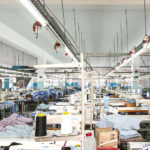 A US apparel manufacturer, in his recent post on forbes.com, has revealed that fashion companies generally fix their MSRP (Market Suggested Retail Price) at least 400% of the manufacturing cost. Giving an example, he says that if a manufacturer makes the T-shirt for $5, he sells to a Retail chain for $10. The retailer, in turn, sells this T-shirt to the consumer at $20. According to him, brick and mortar retailers generally charge at least a 100% margin on their products to cover the cost of the T-shirt, rent, employees and overhead. Hence, the consumer has to pay $20 for a T-shirt that costs $5 to make. Since I was reading a post on Forbes, I was curious to know the manufacturing cost of T-shirts of certain premium brands that retail at as high as $100! What factors are considered while fixing their MSRP? I was greatly disappointed since I didn’t find any information on this aspect.During a recent Quality Garment Network event – organized by the world market leader in ironing and pressing machines, Veit, in Southern Germany – it was pointed out by the International Apparel Federation that improvements in the global fashion industry was necessary ‘because parts of the industry have gotten caught in a low price spiral whereby continuous pricing down has distorted the consumer’s sense of value of clothing.’ Interestingly, the title of the keynote address by the IAF’s Deputy Secretary General, Matthijs Crietee, was ‘The global garment system, a travelling circus still, or becoming a more ‘normal’ industry’.
A US apparel manufacturer, in his recent post on forbes.com, has revealed that fashion companies generally fix their MSRP (Market Suggested Retail Price) at least 400% of the manufacturing cost. Giving an example, he says that if a manufacturer makes the T-shirt for $5, he sells to a Retail chain for $10. The retailer, in turn, sells this T-shirt to the consumer at $20. According to him, brick and mortar retailers generally charge at least a 100% margin on their products to cover the cost of the T-shirt, rent, employees and overhead. Hence, the consumer has to pay $20 for a T-shirt that costs $5 to make. Since I was reading a post on Forbes, I was curious to know the manufacturing cost of T-shirts of certain premium brands that retail at as high as $100! What factors are considered while fixing their MSRP? I was greatly disappointed since I didn’t find any information on this aspect.During a recent Quality Garment Network event – organized by the world market leader in ironing and pressing machines, Veit, in Southern Germany – it was pointed out by the International Apparel Federation that improvements in the global fashion industry was necessary ‘because parts of the industry have gotten caught in a low price spiral whereby continuous pricing down has distorted the consumer’s sense of value of clothing.’ Interestingly, the title of the keynote address by the IAF’s Deputy Secretary General, Matthijs Crietee, was ‘The global garment system, a travelling circus still, or becoming a more ‘normal’ industry’.
The garment industry has got habituated to be continuously on its feet and keep running in search of production locations of cheaper labor costs, the world over. Therefore, the IAF has been actively trying that the apparel makers must change their focus “From moving production to improving production.” The IAF is quite optimistic that a shift away from ‘moving production’ to ‘improving production’ will help maneuver the industry out of the trap of cheap labor costs. The industry’s madness to ‘move’ instead of ‘improve’ in reaction to rising production costs (and to respond to the continuous price pressure in consumer markets) can never be the long-term solution for anything.
It is, indeed, very baffling to notice this rush for migration to low labor cost production locations in spite of the widely known fact that the labor costs actually account for only a small portion of the total value of most clothing items. It is hard to understand why apparel makers just rely on low wages to reduce their price when the same can be done more effectively through productivity improvements both in factories as well as in the supply chain. Another way is to enhance value by adding functionality to the garments. A whole lot of new functional fabrics and garments are now possible thanks to the fast developments in the fields of technical textiles, wearable electronics, and medical textiles, among others. They provide attractive business opportunities without the labor cost worries. Both buyers and suppliers can work together to help each other to get out of the low labor cost mania.
G.D. JASUJA
Managing Editor





